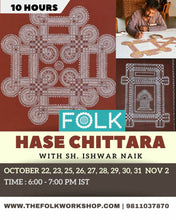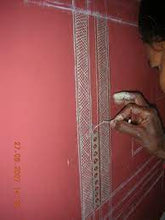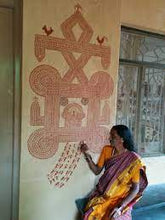Deliverables:
- Lifetime access to recordings of 10 hours of LIVE workshop as a GDrive link.
- Pdfs and references as shared during sessions
- Collection of process pictures/ step by step drawing
- Inclusion to 'Folks of Folk' community for exclusive offers and creative peers bonding
- Online support for queries, reviews, feedback and guidance for and beyond the workshop
ABOUT THE ARTFORM
Hase chitra or hase chittara is a folk art practiced by the Deewaru community in Shimoga, Sagara and Uttara kannada district of Karnataka.
The walls are colored with red mud found abundantly in the region and designs are drawn in white paint derived from rice paste and white mud.
The lines and patterns on these paintings, each symbolize an aspect of nature or depict the religious, social, agricultural practices of the community. The drawing has been seen on the walls, doorframes, and doorsteps in the villages of malenadu region.
It was predominantly practiced by the women folk of the community.
WHAT WE LEARN
Intensive workshops are aimed at providing a wholesome understanding of an artform. In the beginning, we will start from basic patterns and motifs, and move towards knowing about different chittaras made for different festivals or occassions like marriage.
We look to create 2-3 different artworks in the course of the 10 day workshop.
Also, we will learn about the history, cultural relevance and tradition of these paintings. Each chittara is accompanied by a song so music and art is interwoven in this tradition. We will also talk about this tradition.
ABOUT THE ARTIST
MATERIALS:
- Watercolor paper/ handmade paper/ canvas
- Poster / Acrylic colors
- Fine brushes
- Basic stationery
Traditional colors are teracotta red, yellow, black and white






